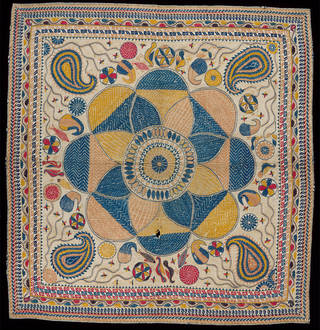Originally made from old, recycled fabrics, the traditional kantha cloth is an example of 'flat', or unwadded quilting, worked on multiple layers of fabric. Bangladeshi or Bengali kantha cloths were made by women for use in their own homes as bedcovers, mats and all-purpose wrappers. The stitching consists of embroidered patterns, ranging from simple floral motifs to elaborate scenes, combined with running-stitch quilting in a colour matching the background fabric. On older quilts, the quilting runs around the embroidered motifs, a technique known as echo quilting.

In the past, kanthas were made from layers of fabric, often old, worn sari lengths, softened by wear and washing. Coloured threads were pulled from the sari borders to be reused in the decorative stitching. One benefit of using well-worn saris was that all the fabric and threads were colour-fast and unlikely to fade any more than they already had.
One example from the early 20th century in our collection is a small, rectangular coverlet, or bedspread, made up of layers of cotton, with the top layer un-dyed, providing a simple backdrop to the bold motifs embroidered in red, blue and yellow. The colours have been placed carefully and increase the impact of the relatively simple decorative designs – flowers, spirals and paisley motifs.

Kantha designs are not always so geometrical or regular, however. A brightly coloured sitting mat in our collections is decorated with scenes of human figures, Hindu deities dressed as urban Bengalis, animals and plants. The scenes show the goddess Devi Chandi standing on a lion fighting the demons Chanda and Munda, who were soldiers of the demon Shumbha; Krishna playing the flute, with Radha and two attendants; Rama and Sita enthroned, with the monkey god Hanuman paying homage before them, with either Bharata or Lakshman holding a parasol and another attendant with a fly-whisk; and a goddess, probably Lakshmi the goddess of wealth, enthroned, with Kartik with his peacock and Lakshmi's vehicle the owl to her right.

Another early-20th-century kantha coverlet in our collection is quilted in a minute running stitch closely worked all over the surface to create an effect of fine ripples. The white ground features bold stylised rosettes, with a number of striped and chequered 'petals', embroidered in mainly red and black cotton with details in yellow and green.

Today, kantha-making has been embraced by a number of projects aimed at preserving traditional skills and generating income for communities. New fabrics are often used, and the word kantha has come to describe the stitching style rather than the object itself. The style is now regarded with pride as a symbol of Bangladeshi culture.



